Compass Saws Versus Table Saws-Or What’s the Difference?
Compass saw, are they still valid saws?
Well, in my view, yes! Especially if you do indeed want more from using hand tools than their mechanised alternatives. You’ll be surprised how effectively they work provided you do indeed understand basics manufacturers of mass-made saws usually don’t. We’ll cover that as we go.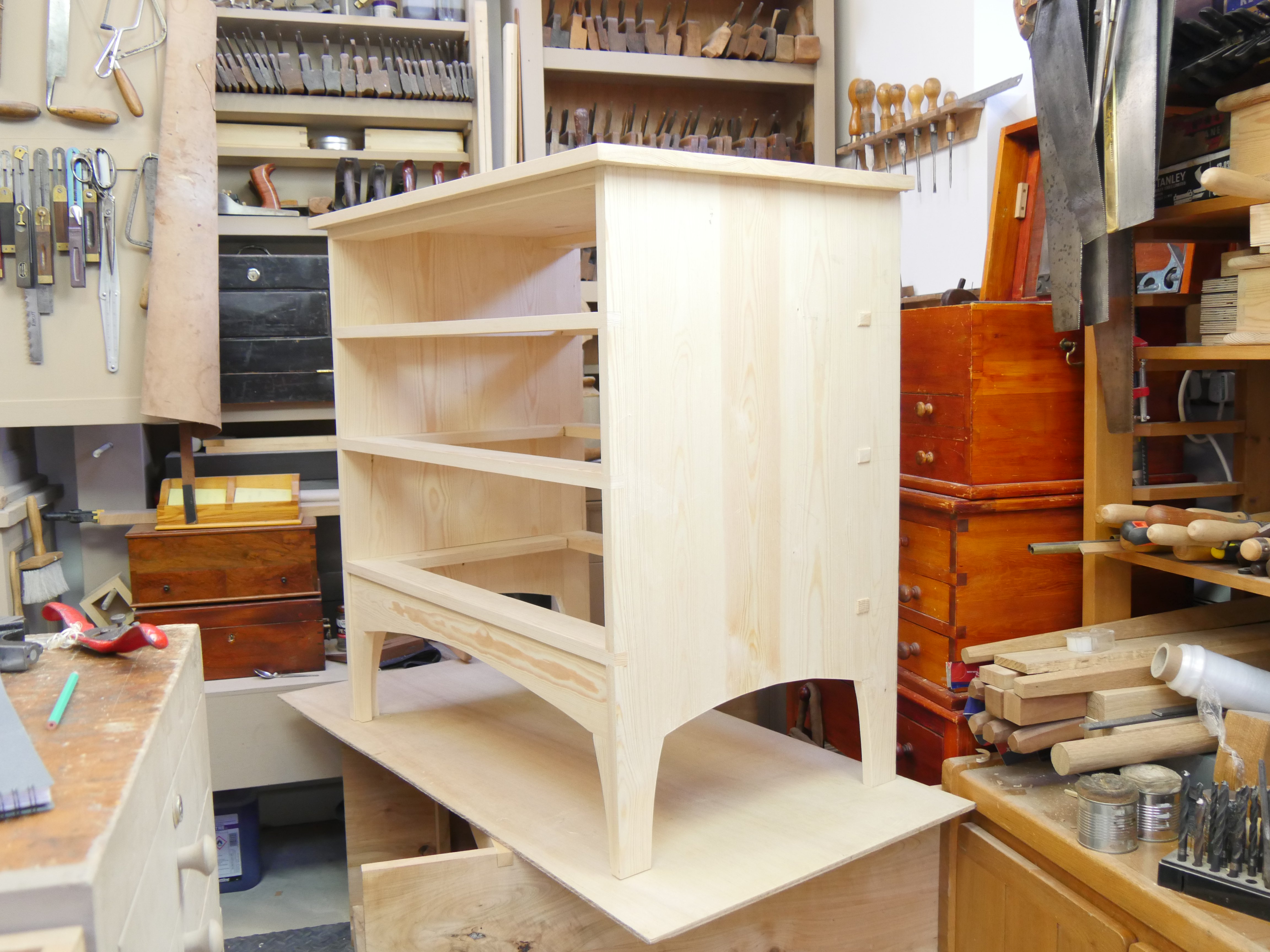
Working on the cherry dresser, er, sorry, “chesterdraws!”, I pulled out my two compass saws and touched them up with the saw file ready for cutting the arching I needed. You may want to know some things from my past to consider what you do into your future. This is about equipping rather than mere nostalgia. These saws cut wood well, but, as with most saws, they must be sharpened to task to cut wood as effectively as possible. That means they should be sharpened specifically for cross- and ripcut operations. Cutting with a compass saw generally means the work shifts from one cut type through a transitional phase into a ripcut. In other words if you are cutting say a circular tabletop for example, depending on the start point, you soon discover that the orientation of the grain shifts as you follow the circumference line. That means the saw you use should generally be changed and that is why a one-saw-cuts-all-view doesn’t work too well at all. Better to change saws at intervals because a ripcut tooth pattern will tear and jibe at cross-grain cutting points and a crosscut pattern tooth will seem like you are dragging through molasses if used to cut along the grain.


Compass saws, a breed apart or a workhorse for curved work?
Compass saws were usually a fairly rough and ready, fairly tough saw, primarily because of the thickness of the saw at the tooth side and then they have fairly large teeth too. Mostly they could be had with a tooth size of around 8-10 per inch and yet the saws were fairly short. You probably won’t find many of any at all with more nor less teeth per inch than that either as they were fairly constrained and punchy saws with regards to functionality. In furniture making and joinery they were used for all types of circular or curved work and mostly in 1-2″ stuff.
The table saw was a different animal but looked similar
Don’t be confused, the compass and table saws are long and skinny both but with subtle differences, nuances if you will. In addition to compass saws thrived an old-order saw we call the table saw. With it’s 1″ wide blade consistent or mildly tapered from narrower at the toe and only marginally wider into the handle, this saw had an exceptionally thick edge into which the teeth were cut and then a very thin spine. This tooth to back taper was what allowed the saw to follow a consistent circular path in the cutting of circular and oval tabletops. Again, this saw too had largish teeth and the teeth were profiled for either a ripcut or crosscut because these too were used for cutting both with and across the grain or indeed a hybrid cut in transitioning from one cut type to the other.
So why the two saw types?
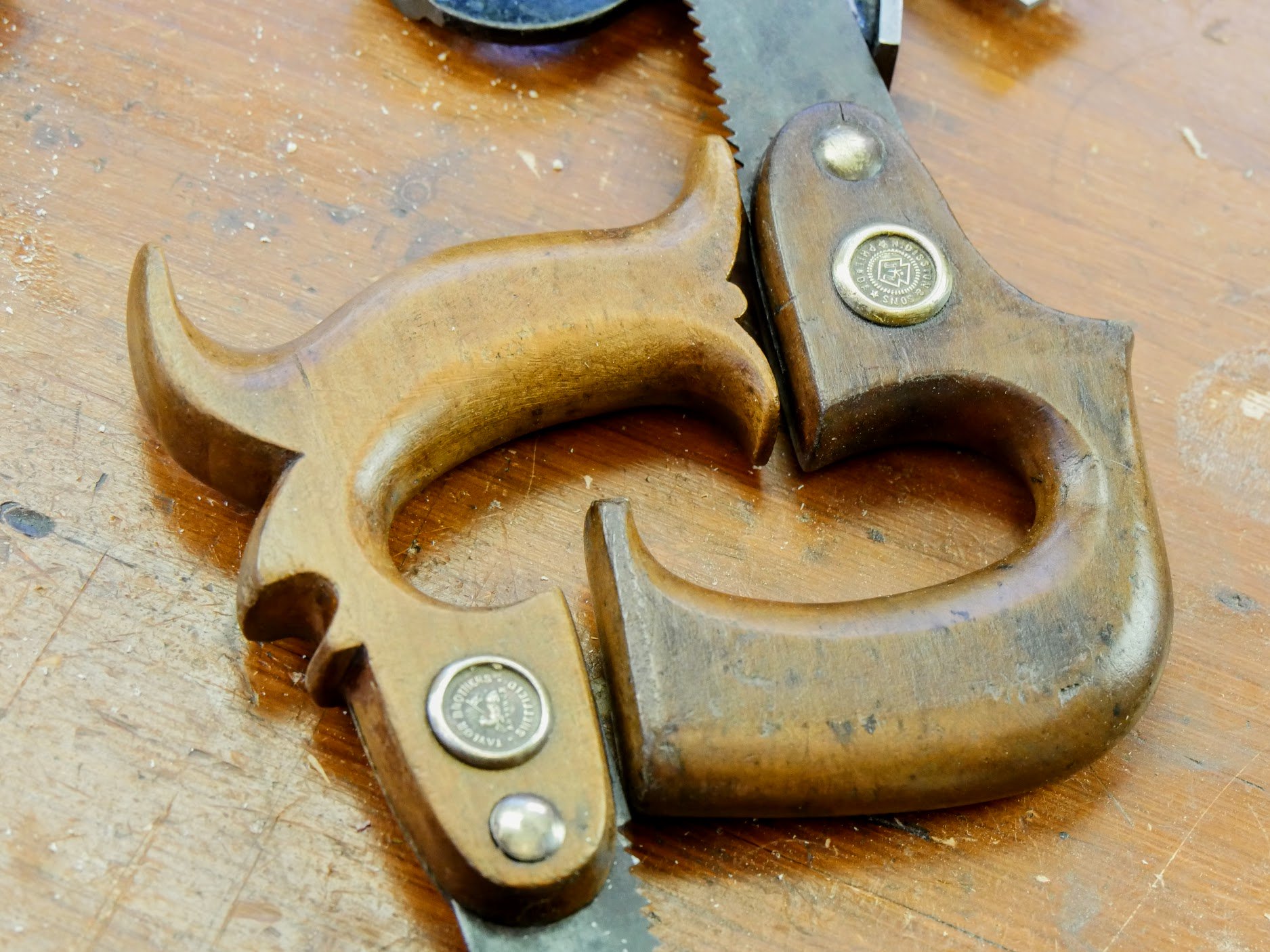
The table saw was a dedicated saw. Rarely would it suit the variation of work joiners did in say stair work with shaped balusters, trestles, scrolls and much, much more. The thicker and heavier table saw allowed extra thrust in the essential power-cuts yet resisted any associated buckling under pressure.

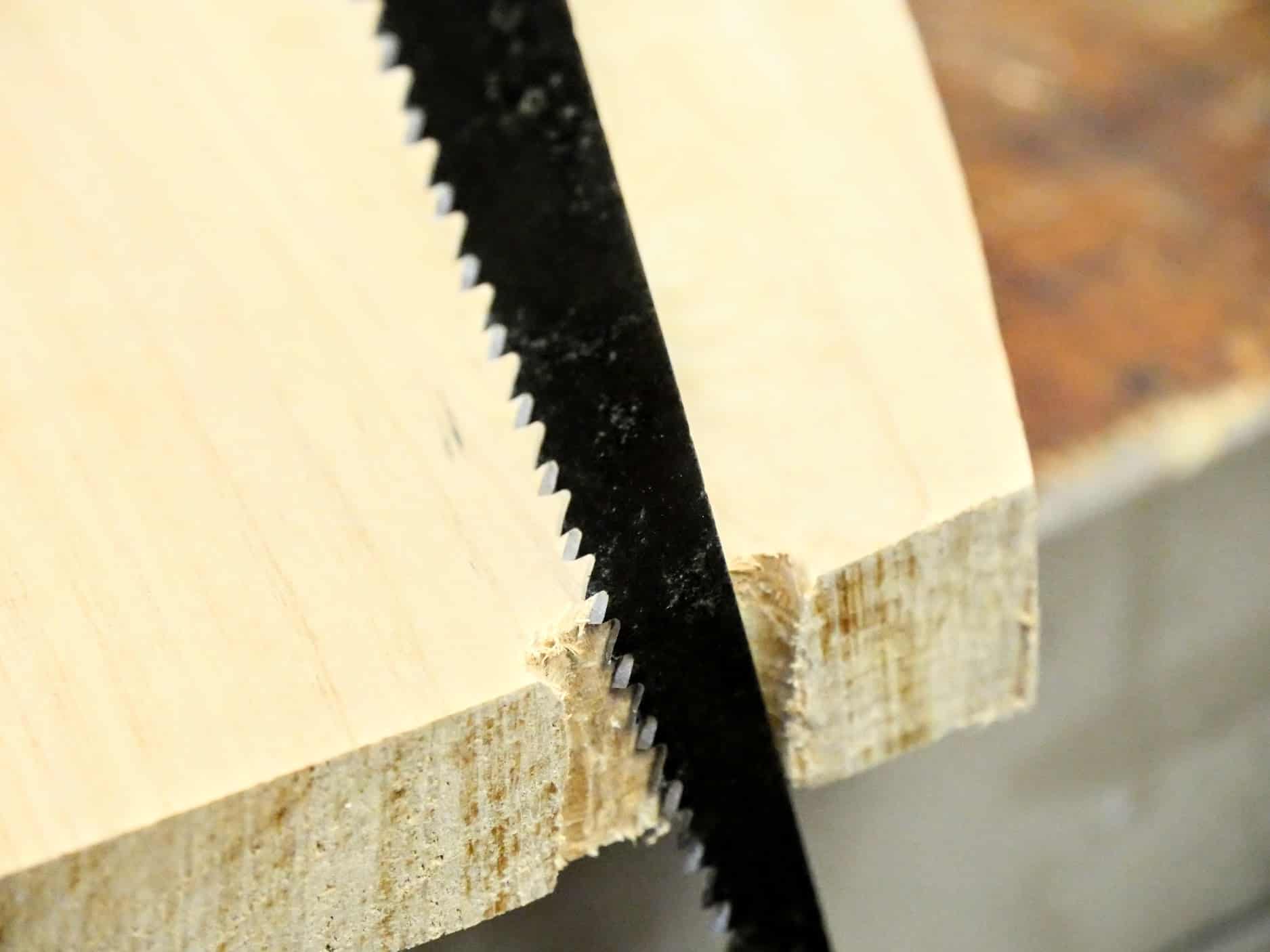
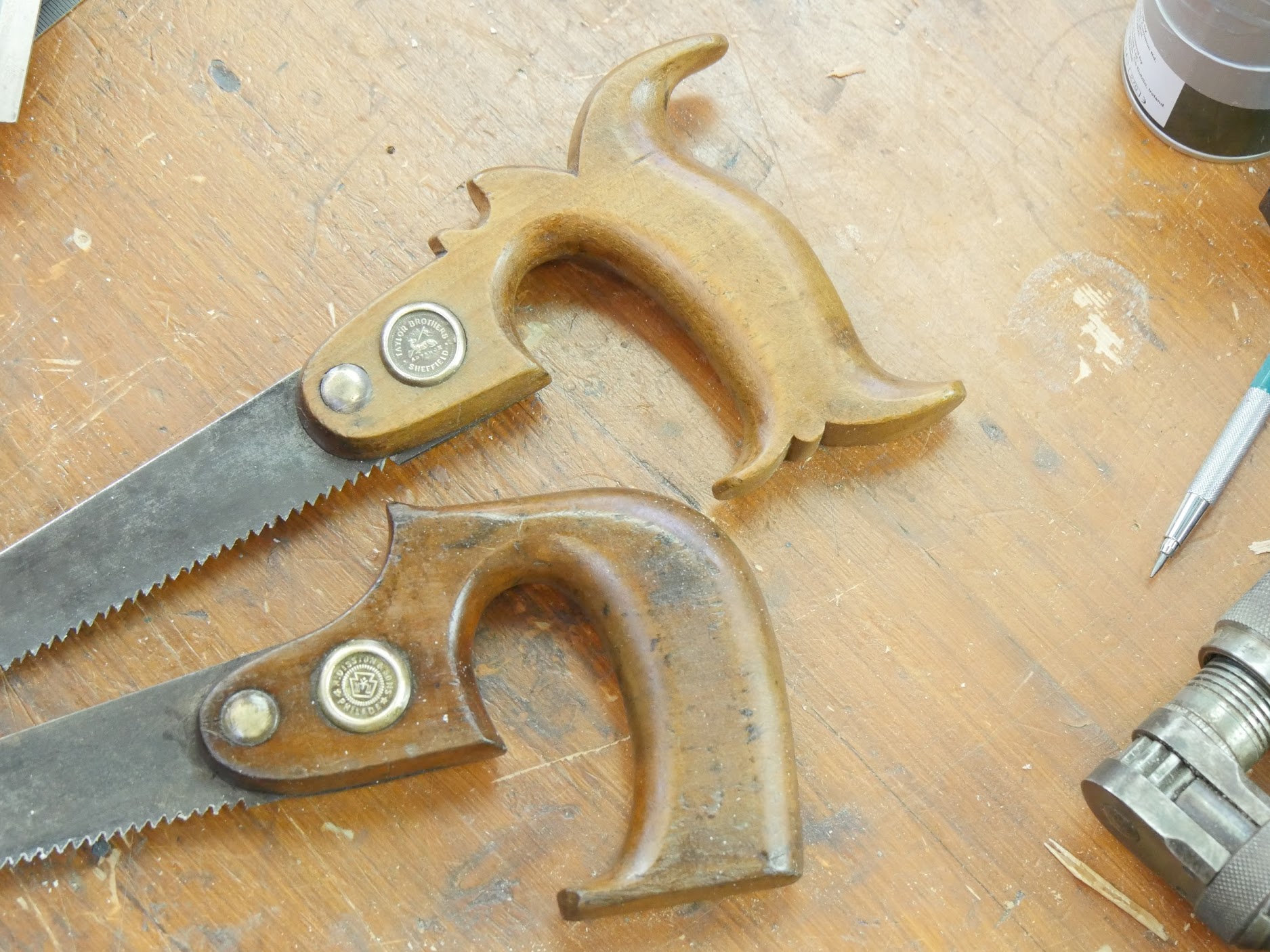
Kneeling on top of the table blank on sawhorses a man could put upper shoulder to maximise overhead cuts. It was effective. Compass saws were finer in section, more slender if you will and lighter really. This is not so apparent until you use them but the difference is indeed there. Whereas table saws would be started from the edge of the tabletop and worked towards the cut line, compass saws were often started from a hole. With a 1/2″ wide point, the toe end entered the hole and could be jab-cut with the first inch or two to enter on into the cut to develop fuller-length cuts using the whole length of the saw.
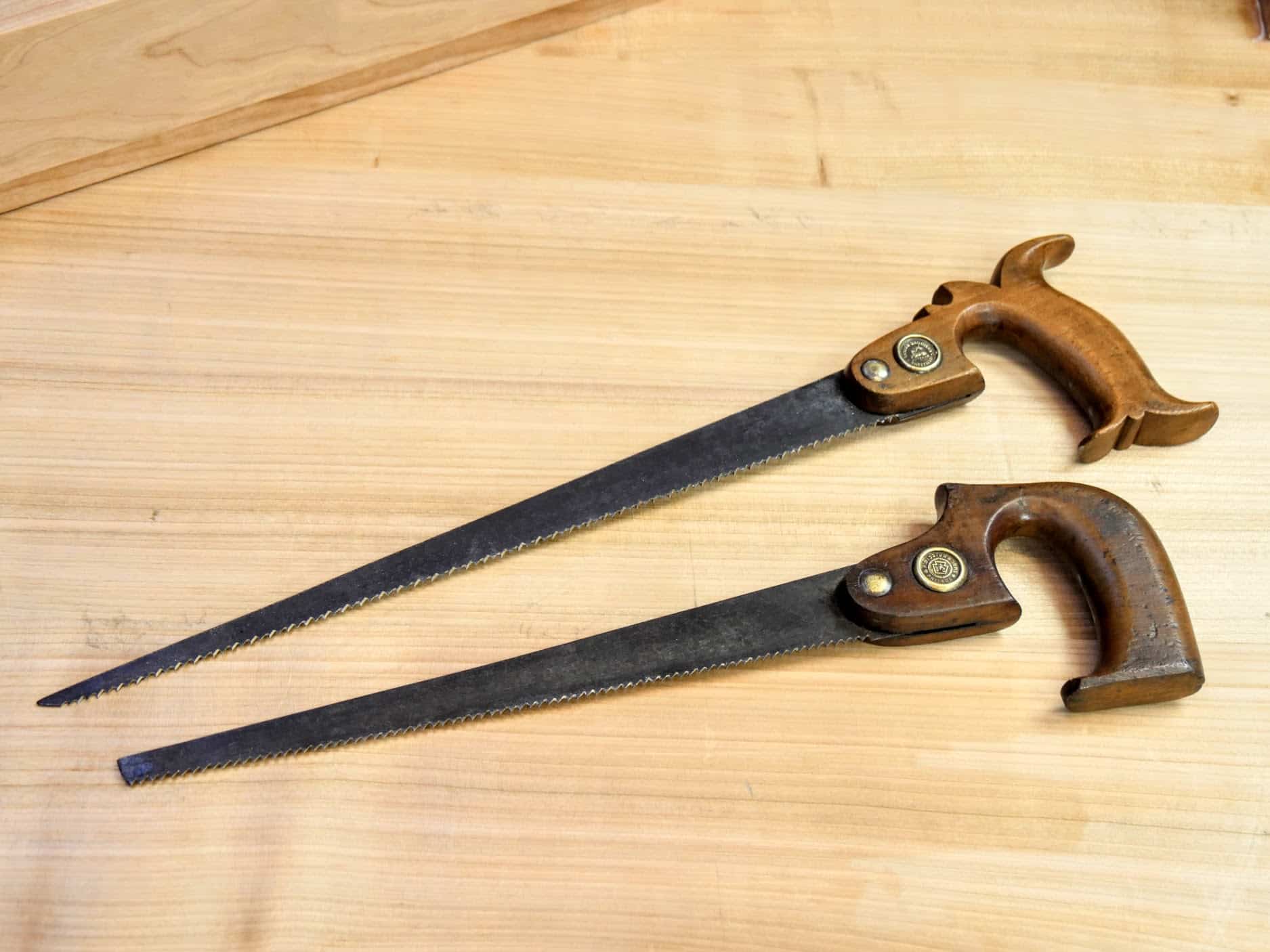
Cutting my prototype pine dresser (at top) and then the cherry version was quite blissful and near noiseless compared to say power jigsaw. Of course the power jigsaws cut a clean cut with the right blades and it is going to be easier, but there is this inexplicable result from effort and energy coming from muscle and brain that just cannot be matched so I enjoyed my blissful, primitive or even ignorant method, exercised, took hard, deep breaths to feed the muscles oxygen and thank goodness had no need for a gym.

In the redwood pine the saw cut well enough but in the cherry it fair soared. My cross arch cuts I started with a series of small side-by-side cuts opened with a drill-driver followed by a fine rasps to encroach up to the cut line. That way I could run the saw teeth directly to the line and the cut started right where I needed it. Anyway, these saws are still common enough but after this article they may disappear for a week or two.


Thanks Paul. As soon as I read this I went out to eBay and ordered mine before they disappear. This dresser is top on my list. I have promised my wife a dresser for the bedroom and was a bit stressed as I thought I would have to design it by myself (still too new to do that). I’m looking forward to this build and will have the saw ready and waiting for when I need it.
Never had the pleasure of handling one of these. It brings to mind the sheetrock jab saw.
Curious if old saws were ever “refurbished” into compass saws.
I have a couple of old panel saws (ebay lot buy) that have too much rust to repair. I was going to turn them into card scrapers but I’m wondering if it would be a worthy experiment to make compass saws out of them.
There’s just enough steel left in them and I’ve been meaning to try my hand at making a handle.
Any advice on how to approach this?
It’s not practical for a compass saw because it does indeed rely on thickness and the taper grind from tooth edge top back edge. The thinness would buckle. It is funny that we all seem to want to salvage something from a saw plate though, scrapers and such. We can’t just let them go. Saw plate because it is hardened spring steel is not easy to cut either so be warned.
Ah, I missed that part in the article. I’m going to hang on to all the saws I have for now, as I keep reading/watching you describe different kinds of tooth configurations for different jobs.
You mentioned doing a follow on series for “Nice To Have Tools”, would love to see you go into more details around saw types and sharpening patterns.
Thank you for all the great content!
How do table saws and compass saws differ from pad saws? Thank you for all you and the crew do!
Mostly to do with size, pad saws are basically keyhole saws so have a thinner blade that passes through the handle so the length of exposed blade can be adjust vi==and locked to the handle via two setscrews. The blades are of thin plate too.
when PS makes toast, toasters become scarce — at least for a few weeks.
I broke my shit laughing reading that
Nearly spit out my coffee reading this! LOL!
Finally a tool il already own and got for nothing I will need to restore them tho, or I could put two on eBay as I’m sure they are selling like hot cakes or ward chisels thanks Paul and team
Thanks again for the helpful blog Paul. Any tips about straightening the blades on these finer saws that have been damaged (not too badly) in the past. Some may have been bent at some stage due to ‘over vigorous’ use to put it mildly and I also suspect some that people may buy from ebay may also be in this condition.
Cheers
Good for a video this question, John. Open up a vise, place the blade inside near the handle, close the vise but not tight, just enough to grip yet allow the saw to be pulled between the jaws. Whichever way the bends are, pull the saw out and away from the vise but bending as you pull into the opposite direction to the bend. It may take one or two tries but it works.
I learned something new today. Thank you. A short video explanation would be fun to watch and provide a visual look at how these saws perform and sound when used correctly. Would I be correct in assuming a bow saw could be used but would not provide as accurate a cut because of its shallow blade?
No, a bow saw with a 1/2″ blade will work fine. Just thread the blade through the hole and retighten for tension and it will give as accurate a cut too.
Paul,
Makes sense when you explain it. My experience with this type of saw is the Keyhole saw. You mention the Keyhole saw earlier. I may have one somewhere in my maze. I’m guessing this type of saw and it variants might need more visual explanation?
Thank you Paul – now I know what I’ve picked up at the car boot! I have a lot of sharpening ahead but I should have a couple of very nice saws once it’s finished.
Thanks for that Paul! I just pulled out an old Bishop compass saw that I picked up a couple of years ago and straightened it as you describe.
Now a question. Should the teeth be set or does the extreme back to tooth line taper make this unnecessary? (My saw has 7 teeth per inch, filed crosscut.)
You can still order a Stanley FatMax 17-205 12-Inch Compass Saw on Amazon for $13.99 ($9.99 Prime). This saw is a replacement for an old keyhole saw that broke on me. It works great and is just what Paul is telling us about. Sorry UK users, I don’t know if this is available for you.
Yes but if you get one of those clever new jigsaws you see in adverts they are totally silent now. I am amazed at the new technology we have available . (British humour ).
What is the accessory used when crosscutting on the table saw?
It’s called a tablesaw sled – home made jig with strips or strip that fit into the tabletop of the saw to guide the sled across and into the blade.
I know this is an old thread but I just found it :(.
What is the U.S. name for “table saw?” Searching that term leads, as expected, to motorized machines.
Thanks.
Mark
Vernacular is everything. Allas, even in the UK a table saw can be one of two things, a circular saw and a handsaw developed in the 17c for hand cutting round cuts. The US had its version of the handsaw type I speak of as all US made tools originated mainly from European masters as migrants to the continent.
At the risk of needlessly dredging up an old thread, I do have a nagging question for Mr. Sellers.
A local used hardware shop near me in Michigan just closed its doors and I was able to purchase 2 sawblades for $3 each. One is a standard compass saw blade, and the other throws me for a loop. Imagine a Disston D-8 skewback rip saw, scaled down in all dimensions to maybe a foot in length, and with identical handle attachment holes to any regular keyhole saw blade. Clearly it was meant to be removeable, and it is the normal length for a table or compass saw, but as a thin plate blade that is over 4 inches wide at the heel and probably 2 inches at the toe, would it even be useful for a curved cut?
What use might it have had?